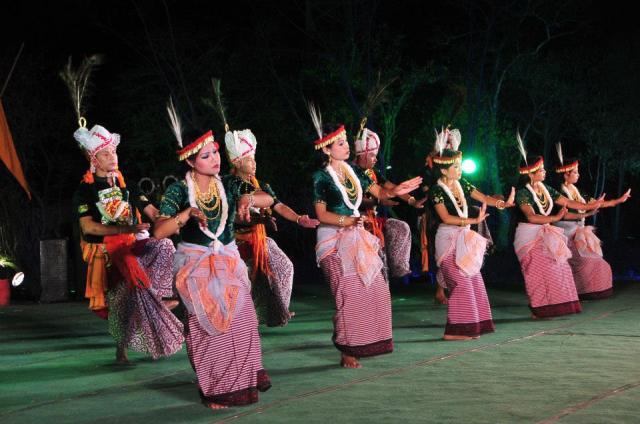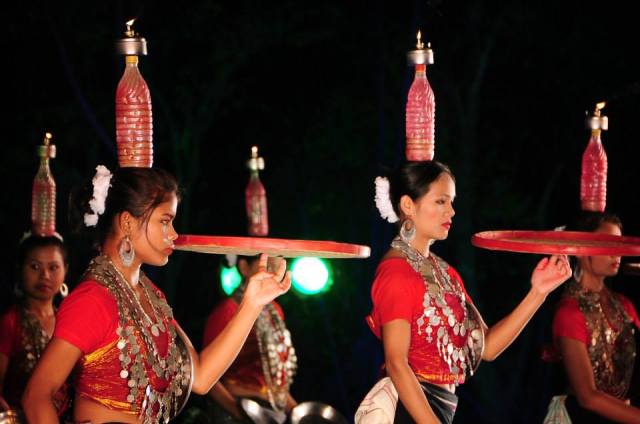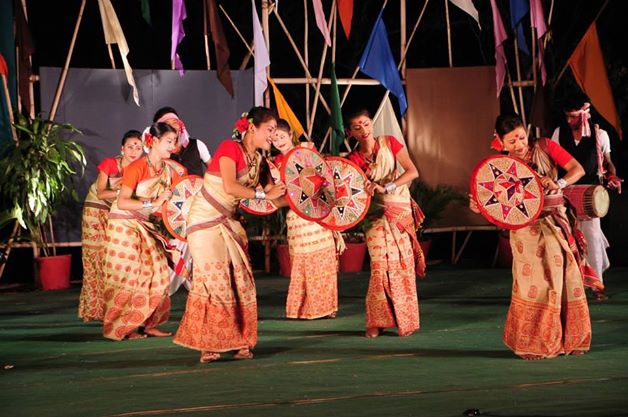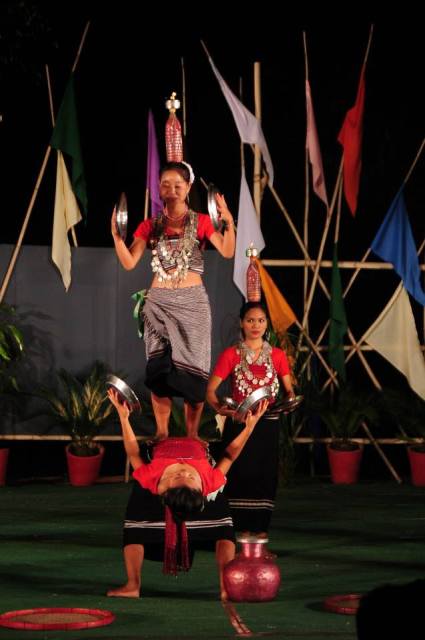Tree frames lit in hues of Jasmine, Green and Reds silhouette cloth backdrops of tan and neem Above, lilac, saffron and gold hang like coloured prayer flags.
The air is cool now. Jupiter rides high above a quarter moon. An hour before, the harsh glare of sweat exploded in downpour over the old city. Lightening forks distantly, a madrassa of white skull capped youth find their mosque as dust blows over the blackened complexion of a prone street dweller by Kamla Park. Then the rush of rain flushes the air as I find shelter and coffee at Park View Fast Food Restaurant .
Now, as I admire the strength and agility of tribal dance I wonder whether good intentions are enough to save Tribal Culture.
A series of dancers where hats bound by strands of upright flowers. I am struck by the unity of design as much as by the variation f nature. The hats are not the factory designs of microscopically perfect regularity. Flower stems, like nature, have their own fractal chaos, that reminds me of the recursive ascension to mount Meru depicted in a Hindu temple roof, or the internal search within the unadorned inner sanctum, garbhagrha, or “womb room”, to be reborn again.
The central energy of folk art is spiritual in an increasingly material world. This, wrote Doctor Narmada Prasad Gupta, has resulted in material and spiritual seen as antithetical opposites, like black and white. The natural and simple life is being lost because we have lost the purity of life that sees material and spiritual as an organic whole.
It is easy to be romantic of the past. It is easy to blame British or Muslim invaders “corrupting” a tribal purity. Others, like Vardana Shiva, suggest the masculinised Aryan invasion, conquered the more inclusive Matrisitc cultures that preceded them.
The village is no longer distant from the politics poverty, exploitation and manoeuvrings.
Tribal life found strength in its diversity, which modernity threatens to homogenise. The masculinised cultures likes to simplify, but nature, and the tribes dependent on her, thrive in diversity.
So I am torn.
The wonderful beauty of tribal dance, performed so stunningly at the 3 day Poorvotsav, a North Eastern Tribal Dance Festival, at ,the Indira Gandhi Rashtriya Manav Sangrahalaya (Igrms) Bhopal leaves me in awe and sad.
The explosion in interest in Tribal art is a beautiful here in Bhopal. However, unless the elite see beyond nature destroying production the Tribes will not survive.
Tribes thrive in the rich natural havens of mountains, rivers and trees. In our technologically destructive world, where life styles corrupted and ruined
Every day in the City of Lakes green farmland is being shredded into another apartment block.
While showing wonderful dance and art in a city centre is marvellous and important does it support the thousands of practitioners of the art in a distant village? A short recording does wonders to promote an art to an unknowing urban audience yet also risks losing the hundreds of subtle variations of a dance unrecorded elsewhere.
Then there is the onslaught of Bollywood, as beautiful as that is in itself.. The travelling performers of Rajasthan for instance have complained people want renditions of the latest glitzy movie and no the unglamorous traditional performers.
I am in awe every tribal performance I visit here. The bright red frocks sashed in tan are beautiful. The men in black tunics and white pyjama are a delight. The incredible musculature of a woman aching backward stuns me. Without the support of her hands another dances on her stomach.
As I return home, a lift offered me by a local near to my Shahpura home, he asks me if I attend church, pointing out the Campion church near home. I politely decline but thank him for the thought.
My thoughts ask instead how we can inclusively keep alive – indeed help make thrive – the knowledge, experience and folk sensitivity that is Tribal India.
.
Images for this post are supplied from the IGRMS, Bhopal.






I love the questions raised and the perspective you’ve offered. Thanks for an inspiring read!
LikeLike
Thankyou Sweta,and it was wonderful to meet you when I visited Brisbane last!
LikeLike